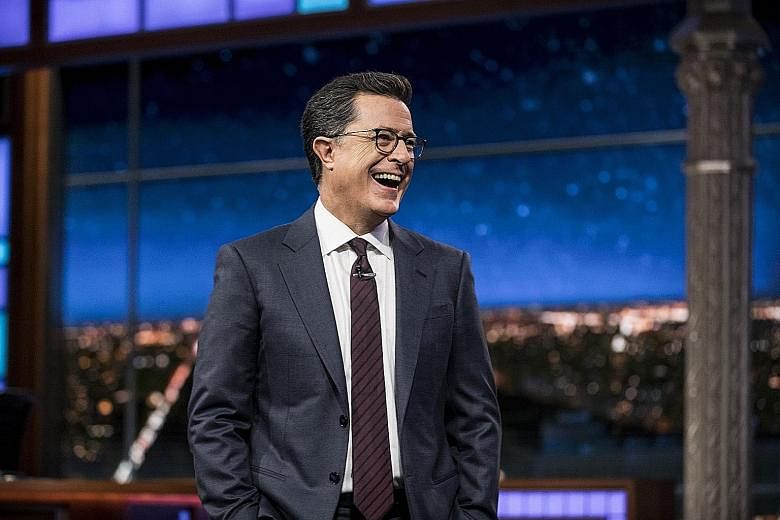NEW YORK • Several things have been credited with driving Stephen Colbert's recent ratings surge - liberals craving a safe space and the host being more comfortable as the anchor of his own late-night show on CBS.
But when the September-to-May television season ended on Wednesday night, Colbert was the victor in total viewers over Jimmy Fallon because of an unlikely reason: the DVR (digital video recorder).
Colbert's remarkable comeback is one of the biggest stories in TV and it is the first time in 22 years that CBS will best NBC in the time slot other than 2010, when Conan O'Brien was removed from The Tonight Show in favour of a return to Jay Leno.
And although Colbert, 53, has been winning in total viewers on an almost nightly basis for some time - he has had more total viewers than Fallon for 16 consecutive weeks - those victories alone would not have been enough to narrow the deficit he faced overall just a few months ago.
Nielsen's season-to-date data includes seven days of delayed viewing. It is there that Colbert has made up tremendous ground on Fallon, racking up big numbers in an area where nightly network talk shows are usually not a factor.
Viewers are fine with catching up on a scripted drama a week after it aired, but who wants to watch Monday night's talk show on a Friday when most jokes will have gone stale?
Primetime shows often depend on significant DVR and on-demand views to goose their numbers.
The top-rated show in broadcast, The Big Bang Theory, sees its ratings jump 35 per cent when a week of delayed viewing is factored in.
Advertisers examine three- and seven-day delayed data when considering how much to pay for commercial time on a show.
But nightly talk shows are different. In the 2012 to 2013 season, for instance, David Letterman's The Late Show saw only a 2 per cent gain and Leno got a 3 per cent bump from seven days of delayed data, according to Nielsen.
By the time Fallon took over The Tonight Show in 2014, those numbers rose. Fallon saw his delayed viewers rise by 11 per cent.
Colbert has taken it to a new level. This season, he has seen his numbers jump 18 per cent, thanks to delayed viewing.
Although gains this size are rare among broadcast networks, they are less so among cable late-night shows. Trevor Noah's The Daily Show, for example, shows considerable gains via playback although his overall audience is much smaller.
Since January, when Colbert started his weekly winning streak, his audience has jumped an average of 20 per cent when seven days of delayed viewing numbers are factored in, according to Nielsen, a net of an additional 551,000 viewers.
Fallon's show added 212,000 viewers - a rise of 8 per cent - and Jimmy Kimmel's ABC show had an extra 81,000 viewers for 4 per cent growth.
Colbert still trails Fallon in a significant statistic - the important 18- to-49-year-old demographic.
Fallon has a rating point of 0.81 for the season compared with Colbert's 0.58 and Kimmel's 0.48. But his growth in total viewers is a significant change in a late-night battle that had gone NBC's way for a long time.
At the moment, just 22,000 viewers separate Colbert and Fallon on a nightly basis - Colbert is averaging 3.19 million viewers compared with Fallon's 3.17 million. But by the time the season-to-date delayed data through May 22 is tabulated - which will take several weeks - the gap between them will expand further.
The current numbers take into account shows only through the first week of May. They do not include a May 9 show that was a big one for Colbert. Then, he hosted a Daily Show reunion of sorts with Jon Stewart, Samantha Bee, John Oliver, Ed Helms and Rob Corddry.
He had an audience of 3.78 million people that night - one of his biggest audiences since he took over. But over the next three days, an additional 1.3 million people watched the show, bringing the total audience to 5.1 million. That is the biggest tally for an episode of The Late Show since September 2015.
That week was good for Colbert, who was perhaps buoyed by the attention he got when it became known that the Federal Communications Commission (FCC) was looking into whether he had violated its rules when he made an off-colour joke about United States President Donald Trump.
And this week has not been too bad either. In addition to finding out that he was going to win the season ratings battle, Colbert also found out he was off the hook with the FCC. It said on Tuesday that no action would be taken against him.
NYTIMES

